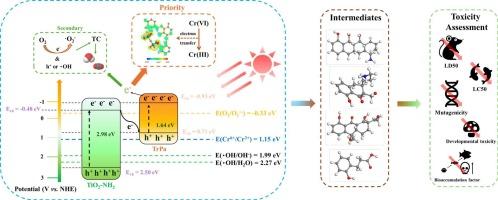通过Z-scheme COF/TiO2-NH2异质结增强了四环素降解和铬脱毒的双功能性能
IF 6.7
2区 工程技术
Q1 ENGINEERING, CHEMICAL
引用次数: 0
摘要
废水中新出现的污染物和重金属的共存带来了巨大的环境风险,需要制定有效和可持续的修复策略。本研究合成了一种共价集成的z型异质结光催化剂(TrPa/TiO2-NH2),用于在模拟阳光照射下同时光降解四环素(TC)和光还原六价铬(Cr(VI))。通过光致发光、电化学阻抗谱和瞬态光电流测量表明,该复合材料具有增强的电荷分离效率。在优化条件下,TrPa/TiO2-NH2在120 min内实现了93.7%的TC降解(kobs = 0.018 min - 1)和几乎完全的Cr(VI)还原(kobs = 0.025 min - 1),并在实际水基质中多次循环中保持了良好的稳定性。力学分析和密度泛函理论(DFT)计算表明,光生电子主要还原Cr(VI),这一过程在热力学上比O2还原更有利。这种顺序还原途径解释了为什么•O2−的存在轻微影响Cr(VI)的去除,但在TC氧化中起着至关重要的作用。同样,活性物质清除和电子顺磁共振分析证实,•O2−、h+和•OH是TC氧化的原因,而光生电子主要介导Cr(VI)的还原。这项研究提供了基于cof的Z-scheme光催化剂的机理见解,并提出了解决复杂废水污染的有前途的策略。本文章由计算机程序翻译,如有差异,请以英文原文为准。

Enhanced dual-functional performance on the tetracycline degradation and chromium detoxification via Z-scheme COF/TiO2-NH2 heterojunctions
The coexistence of emerging contaminants and heavy metals in wastewater poses significant environmental risks, necessitating the development of efficient and sustainable remediation strategies. In this study, a covalently integrated Z-scheme heterojunction photocatalyst (TrPa/TiO2-NH2) is synthesized for the simultaneous photodegradation of tetracycline (TC) and photoreduction of hexavalent chromium (Cr(VI)) under simulated sunlight irradiation. The composite exhibits enhanced charge separation efficiency, as demonstrated by photoluminescence, electrochemical impedance spectroscopy, and transient photocurrent measurements. Under optimized conditions, TrPa/TiO2-NH2 achieves 93.7 % of TC degradation (kobs = 0.018 min−1) and nearly complete Cr(VI) reduction within 120 min (kobs = 0.025 min−1) and also maintains excellent stability during multiple cycles in real water matrices. Mechanistic analysis and density functional theory (DFT) calculations reveal that photogenerated electrons predominantly reduce Cr(VI), a process that is thermodynamically more favorable than O2 reduction. This sequential reduction pathway explains why the presence of •O2− slightly affects Cr(VI) removal but plays a vital role in TC oxidation. Similarly, reactive species scavenging and electron paramagnetic resonance analyses confirm that •O2−, h+ and •OH are responsible for the oxidation of TC, while photogenerated electrons primarily mediate the reduction of Cr(VI). This study provides mechanistic insights into COF-based Z-scheme photocatalysts and presents a promising strategy for addressing complex wastewater contamination.
求助全文
通过发布文献求助,成功后即可免费获取论文全文。
去求助
来源期刊

Journal of water process engineering
Biochemistry, Genetics and Molecular Biology-Biotechnology
CiteScore
10.70
自引率
8.60%
发文量
846
审稿时长
24 days
期刊介绍:
The Journal of Water Process Engineering aims to publish refereed, high-quality research papers with significant novelty and impact in all areas of the engineering of water and wastewater processing . Papers on advanced and novel treatment processes and technologies are particularly welcome. The Journal considers papers in areas such as nanotechnology and biotechnology applications in water, novel oxidation and separation processes, membrane processes (except those for desalination) , catalytic processes for the removal of water contaminants, sustainable processes, water reuse and recycling, water use and wastewater minimization, integrated/hybrid technology, process modeling of water treatment and novel treatment processes. Submissions on the subject of adsorbents, including standard measurements of adsorption kinetics and equilibrium will only be considered if there is a genuine case for novelty and contribution, for example highly novel, sustainable adsorbents and their use: papers on activated carbon-type materials derived from natural matter, or surfactant-modified clays and related minerals, would not fulfil this criterion. The Journal particularly welcomes contributions involving environmentally, economically and socially sustainable technology for water treatment, including those which are energy-efficient, with minimal or no chemical consumption, and capable of water recycling and reuse that minimizes the direct disposal of wastewater to the aquatic environment. Papers that describe novel ideas for solving issues related to water quality and availability are also welcome, as are those that show the transfer of techniques from other disciplines. The Journal will consider papers dealing with processes for various water matrices including drinking water (except desalination), domestic, urban and industrial wastewaters, in addition to their residues. It is expected that the journal will be of particular relevance to chemical and process engineers working in the field. The Journal welcomes Full Text papers, Short Communications, State-of-the-Art Reviews and Letters to Editors and Case Studies
 求助内容:
求助内容: 应助结果提醒方式:
应助结果提醒方式:


